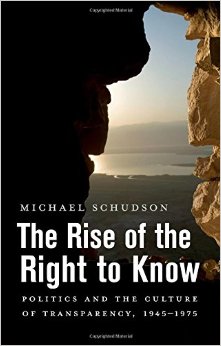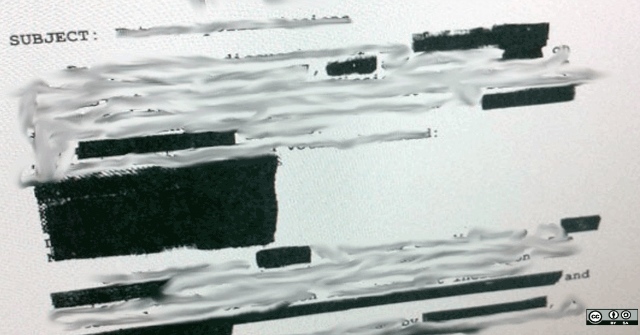Book Review: The Rise of the Right to Know: Politics and the Culture of Transparency, 1945-1975 by Michael Schudson
How has governmental and corporate transparency become a fundamental element of political culture? In The Rise of the Right to Know: Politics and the Culture of Transparency, 1945-1975, Michael Schudson provides a historical account of how information disclosure by governments and corporations has emerged as an integral part of public life in the second half of the twentieth century. As freedom of information is seen to be a crucial means of holding policymakers to account, the need to understand its history and development makes this book an essential read for anyone researching politics and open government, writes Monica Horten.
If you are interested in this review, you may also like to listen to a podcast of Michael Schudson’s lecture at LSE, ‘Expectations of Openness in an Age of Secrecy: Where the ”Right to Know” Comes From’, recorded on 13 January 2016.
The Rise of the Right to Know: Politics and the Culture of Transparency, 1945-1975. Michael Schudson. Harvard University Press. 2015.
 In 2016, the right to know is something we take for granted. We consider it as normal that data from public bodies can be disclosed. We expect packaging to tell us the calories and ingredients in food. Environmental impact assessments are standard practice. However, as Michael Schudson ably demonstrates in this very readable book, the making available of such information is a relatively new phenomenon.
In 2016, the right to know is something we take for granted. We consider it as normal that data from public bodies can be disclosed. We expect packaging to tell us the calories and ingredients in food. Environmental impact assessments are standard practice. However, as Michael Schudson ably demonstrates in this very readable book, the making available of such information is a relatively new phenomenon.
The Rise of the Right to Know: Politics and the Culture of Transparency, 1945-1975 is a historical account of how information disclosure by governments and corporations has transformed public life in the latter part of the twentieth century. It is a transformation that has had a profound effect on how governments and corporations interact with citizens. The book outlines an evolution from a culture of secrecy, where those in power did not tell citizens what they did not need to know, to a new political culture that is predicated on what we now call ‘transparency’.
Transparency is more than just the release of documents; it concerns the accountability of governments to citizens. As Schudson argues, transparency encompasses due diligence and reporting procedures, both in the legislature and in other public authorities. It applies to past, present and future. Schudson sheds light on the different nuances of transparency as he leads us through a series of policy and legislative case studies.
The book begins in Washington DC in the 1950s, at a time when the executive organs of the US government operated under a shroud of secrecy, shunning accountability. This was also the era of the Cold War between the US and the Soviet Union, when government secrecy was heavily defended. Along came Congressman John Moss – the quiet man who asked questions. Schudson carries us along a trail of changes that led to the Freedom of Information Act (FOIA) in the US, adopted by Congress on 20 June 1966. Today, the FOIA facilitates the disclosure of government documents to any citizen – or even non-citizen – who requests it, and its principles underlie legislation in many other jurisdications. What’s so fascinating about this story is how the FOIA arose neither out of public clamour to know nor, as many believe, out of principles founded in the US Constitution, but rather out of a workmanlike enquiry by the US Congress about examining information from government departments.
The book moves on to discuss how, in the 1960s, US Congess was itself prone to secrecy. It considers the public’s right to know what their political representatives are doing, in a case that illustrates how obscure procedures were unmasked and subjected to legislative reform. Another aspect of transparency relates to risk factors of major public projects. This issue is explored using the story of the National Environmental Policy Act (NEPA) which, in the late 1960s, gave birth to the idea of an environmental impact assessment: a concept that is now embedded in policymaking, requiring disclosure of possible harms to the environment, such as air and water pollution.

Image Credit: Redacted (Open Source)
A strength of the book is that Schudson has not limited himself to state transparency. He broadens the concept to see how it applies in the context of corporate accountability to consumers. He outlines how the labelling of food to disclose its ingredients came into being against a background of resistance by large food corporations. This was something of a revelation, and it’s interesting to see how we may owe our ability to see what is in our food to one very persistent US government official.
A curious aspect of Schudson’s argument is that it says very little about the public. They are the intended beneficiaries of transparency. Did they not want the right to know? According to the book, they do not seem to have demanded it. Instead, the pressure came from elsewhere: ‘Outside the halls of congress, the forces of change had only one major ally: the news media’, Shudson states. And with that, he examines how the role of the media influenced change, notably how an increasingly powerful news media became advocates for government disclosure.
Schudson remarks on how our political forebears almost stumbled into a transparency culture which today’s youth takes for granted. Are there other underlying reasons for this? The final phase of the book incorporates a discussion of contemporary democracy and how the age of transparency has ushered in a new kind of politics. We now have a sprawling, administrative state and increasingly politicised courts. With this has come an increase in the monitoring of state activity by non-governmental groups and think-tanks that call the government to account. In the administrative state, transparency is about highlighting weaknesses in the system. Such monitoring is to a great extent predicated on freedom of information legislation and other forms of state disclosure. In this regard, the book provides a foundation stone for further exploration of the new, Internet-era challenges to government secrecy, such as Wikileaks and Edward Snowden.
From the perspective of the UK, a country that has only had a Freedom of Information Act for some 15 years, 34 years after the US, this book grows on the reader. Here, government officials are reportedly wanting to pare back freedom of information provisions. This book is a reminder that the right to know is not an automatic right. It was hard-won, and fought for by many unknown political soldiers. Even democratic governments do not necessarily consider that openness is a virtue and will resist attempts to prise the lid off their secrets as a matter of course. Despite the flaws in freedom of information legislation, it remains a precious means for citizens to call their policymakers to account. Understanding the history of it should bolster us in protecting it. This book should certainly be on the reading lists of anyone researching politics or open government.
—
This post originally appeared on the LSE Review of Books. It represents the views of the author and not those of Democratic Audit UK or the LSE. Please read our comments policy before posting.
—
Dr Monica Horten is an LSE Visiting Fellow in the Department of Media and Communications. Her research interests are in the field of European policy, at the intersection of the Internet, human rights and copyright. She has published three books addressing key policy agendas of recent years. In that context, she has examined issues related to political transparency and corporate power. She blogs at www.iptegrity.com and tweets @Iptegrity.





 Democratic Audit's core funding is provided by the Joseph Rowntree Charitable Trust. Additional funding is provided by the London School of Economics.
Democratic Audit's core funding is provided by the Joseph Rowntree Charitable Trust. Additional funding is provided by the London School of Economics.
#BookReview: The Rise of the Right to Know: Politics and the Culture of #Transparency, 1945-1975 by Michael Schudson https://t.co/ldPexri74s
RT @democraticaudit: #BookReview: The Rise of the Right to Know: Politics and the Culture of #Transparency, 1945-1975 by Michael Schudson h…
Good review of @mschudson2’s book, The Rise of the Right to Know: Politics and the Culture of #Transparency https://t.co/Ae66g6EDHc
Book Review: The Rise of the Right to Know: Politics and the Culture of Transparency, 1945-1975 by Michael Schudson https://t.co/YJoN1Owwnd
Book Review: The Rise of the Right to Know: Politics and the Culture of Transparency, 1945-1975… https://t.co/Mur0G58YlT
Book Review: The Rise of the Right to Know: Politics and the Culture of Transparency,… https://t.co/SvYQIjyJMl https://t.co/8PxLevy4ga